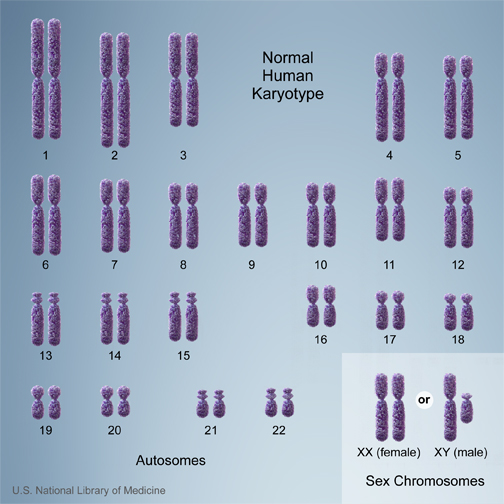In all living things, DNA is essential for inheritance, coding for proteins, and providing instructions for life and its processes. DNA dictates how a human or animal develops and reproduces, and eventually dies.

Human cells normally contain 23 pairs of chromosomes, for a total of 46 chromosomes in each cell.
Proteins
A protein is a complex molecule found in the body that is abundant and is vital for most living functions.
There are many different types of proteins that include structural proteins, messenger proteins, enzymes and hormones. These perform various functions from forming the organs, skin and bones and the body to performing actions and functions via messengers, enzymes and hormones.
How is DNA linked to proteins?
DNA carries the codes for proteins. However, the actual protein differs a lot from the codes present on the DNA. The basic steps include:
Transcription
The first step that occurs is a process known as transcription. Here the information on the DNA is written down onto a different molecule called the RNA. This molecule acts as a messenger to carry the information to other parts of the cell.
Translation
The next step is called translation. In this step, the cell organelles called ribosomes come into play. These ribosomes act as translators by translating the messenger's code into the proper protein format or a chain of amino acids that form the building blocks of the protein. Each amino acid is formed by combining three bases on the RNA.
Modification and folding
The third step is modification and folding and structuring of the final protein and sending it to the required areas in the body.
Coding for proteins
DNA is read by the messengers that break it open into single-stranded polynucleotide chains and is copied into RNA.
RNA forms opposite bases from that present on the DNA. For example, G on the DNA forms C on the RNA strand.
Each of the bases gets together in threes and these form particular amino acids. There are 20 such amino acids. These are also known as the building blocks of proteins.
The amino acids first form a long chain called the polypeptide chain. This polypeptide chain undergoes conformational and structural changes and folds and refolds over itself to form the final complex structure of the protein.
DNA replication
Apart from coding for proteins, DNA also replicates. This helps in a variety of functions including reproduction to maintenance and growth of cells, tissues and body systems.
In this process, the DNA strands, that are tightly wound with each other, unwind and literally unzip to leave several bases without their partners on the other strand and remain along the backbone of the molecule.
The bases are very specific about which base they will attach to and the adenine only pairs with thymine and guanine will only pair with cytosine. Unpaired bases come and attach to these free bases and a new strand is formed that is complementary to the original sequence.
The end result is a strand that is a perfect match to the original one prior to it unzipping. This results in two new pairs of strands and two coiled DNA. Each of the new DNA contains one strand from the mother pair and a new one.
DNA inheritance
DNA is important in terms of heredity. It packs in all the genetic information and passes it on to the next generation. The basis for this lies in the fact that DNA makes genes and genes make chromosomes.
Humans have 23 pairs of chromosomes – a total of 46 chromosomes. Twenty-two of these pairs, called autosomes, look the same in both males and females. The 23rd pair is called the sex chromosomes and differs between males and females. Females have two copies of the X chromosome or XX, while males have one X and one Y chromosome.
Both parents have reproductive cells – sperms in fathers and ovum or eggs in mothers. These sperms and eggs contain half the number of chromosomes – 23 each. When the egg and the sperm fertilizes, this gives rise to a cell that has the complete set. Thus a person inherits half of his or her genes from each of the parents.
Further Reading